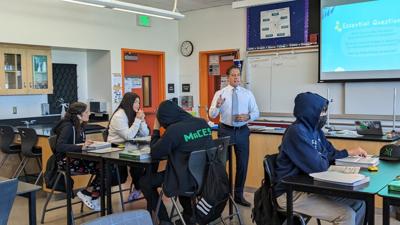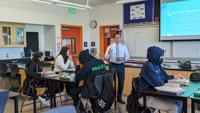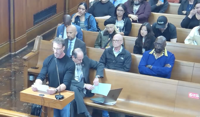
File photo of Alberto M. Carvalho talking to LAUSD students. (Photo: Jacqueline Garcia)
It has been five years since the Covid-19 pandemic hit and despite the difficulties, LAUSD reported that in 2023-2024 the graduation rate reached 87%, the highest of all times. Superintendent Alberto Carvalho said the number was great news because they were talking mainly about students who live at or below poverty levels, including students of color and English Language Learners (ELL).
The higher graduation rates, however, don’t necessarily mean schools are doing better, according to parents and students. Despite the high numbers, in Southeast Los Angeles (SELA) some question whether schools were passing students just to get rid of them.
Data shows that students in the SELA area are graduating at a higher rate than the LAUSD. For the same 2023-2024 school year SELA had a 92% graduation rate. The trend is about the same for previous years.
LAUSD went from 76% in the 2016-2017 school year to 80% in 2019-2020 while SELA went from 86% from 2016-2017 to 88% in 2019-2020.
In March of 2020 the COVID-19 pandemic hit severely across the country. Unexpected changes happened and many students were affected mentally, economically and academically.
Briana Alba, a senior at Huntington Park High School, remembered her anxiety and lack of motivation she experienced when the pandemic started. She was in 7th grade and had been waiting for years to be reclassified from English Learner (EL) to regular English classes. This process was stopped when students were moved to virtual classes.
At that moment she faced a roller coaster of emotions. Many students, including her, faced technical problems, online learning challenges, mental setbacks and lack of individual support like tutoring.
The work was mainly done through packages the students received and had to turn them in after a few days. However, it was common to experience slow internet, computers lagging, video chat that didn’t work, video stopping in the middle of the class, among other issues.
“I knew students who had the privilege to have good WiFi and sometimes they helped us with the screenshots and the videos [of classes] and the emailing them,” she said.
However, schooling would get very unmotivating at times, since it wasn’t anything like she had imagined when she was younger.
“I remember clearly, I was really sad and struggling. It was lonely,” she said. “I was scared of my grades. I didn't know if I was gonna be able to pass or not.”
Alba said the sentiment was shared with her classmates. Most of them felt the teachers didn’t have enough resources to help.
She said she heard about other areas, such as the west side, where wealthier students didn’t have learning issues, despite the pandemic.
“It’s good they have that but for us it was so complicated , it was so stressful,” she said.
After a year and a half, students went back to in-person classes. Adapting to the “new normal” was difficult but students did it. Going from weekly covid testing to wearing masks and washing their hands often became a routine.
While she is no longer an EL student, Alba said she had to stand up for herself for years because her counselor didn’t know or didn’t want to help her. She recognized that much of the issues were because the SELA area lacks resources.
Parents tried to understand and help their children
Lupe Lopez and Veronica Rodriguez are comadres and both have children or grandchildren attending SELA schools. Lopez said when the pandemic hit she was taking care of 10 children and it was really difficult to help them all when classes moved online.
“I was lucky that a few months prior I had taken computer classes and I knew the basics,” she said in Spanish. “But it was impossible to keep all the children focused on one screen.”
Lopez said she has granddaughters who after graduating high school didn’t continue college because they didn’t feel prepared.
Rodriguez has a daughter in the autism spectrum who was in 10th grade when the pandemic hit and she said the help was minimal. When she was moved to online learning, Rodriguez said her daughter wasn’t receiving the classes according to her learning disability. She was placed with the general population despite having autism in level one, meaning she still required some support.
When schools reopened, her daughter went back to school in-person, but she couldn't really wear her face mask because she would get anxious.
“I feel they didn’t really pay attention to students with disabilities,” said Rodriguez.
She graduated last year from Bell High School and was transferred to Alfonso Perez Educational Center, an Adult Transition Center that helps young adults with disabilities gain independence skills in job training, internships, and learn how to use public transportation.
Rodriguez said her daughter lasted only two months there because the staff told her she was capable of doing much more and was referred instead to East Los Angeles College. By this time, her daughter was deceived by the system and decided to take some time off.
Rodriguez believes if the school had paid more attention to her daughter she would have stayed in school.
Plans for SELA’s success
LAUSD Board Member Karla Griego represents SELA and while her role representing District 5 is relatively new–since December 2024–she knows the needs very well as a former community school coordinator.
Griego said long before COVID, students in SELA and across LAUSD were lacking the mental health and wellness support needed to be successful in school. Housing insecurity and access to good paying jobs were also contributing to student struggles in the area.
She said LAUSD is aware that the aftermath of Covid will have a long lasting impact on student academic success. Therefore, they are focusing on extending learning time for students through the Winter and Spring Academies and summer school.
“LAUSD has invested in out of the classroom resources to support the whole child including having more psychiatric social workers, school climate advocates, and college counselors,” she said. “Although the COVID-related federal funding has expired, our board office is committed to ensuring that we maintain these resources and student support at the school site.”
Griego said one of her priorities as a board member is to expand community schools in the SELA region.
These are public schools that partner with the community and act as a hub to provide comprehensive support for students' well-being. Some of the services that community schools offer are counseling, healthcare, and family engagement. They also provide extended learning time, and collaborative leadership and practices for educators and administrators, according to the California Department of Education.
Griego said she is committed to addressing this and other issues affecting the region with the support and input from the students, parents, and the community at large.
“When our public schools are strong and successful, so are our communities. I know SELA communities are powerful and resilient and I am excited to work alongside them,” she said.
This article was produced as a project for the USC Annenberg Center for Health Journalism’s 2024 Data Fellowship.









(0) comments
Welcome to the discussion.
Log In
Keep it Clean. Please avoid obscene, vulgar, lewd, racist or sexually-oriented language.
PLEASE TURN OFF YOUR CAPS LOCK.
Don't Threaten. Threats of harming another person will not be tolerated.
Be Truthful. Don't knowingly lie about anyone or anything.
Be Nice. No racism, sexism or any sort of -ism that is degrading to another person.
Be Proactive. Use the 'Report' link on each comment to let us know of abusive posts.
Share with Us. We'd love to hear eyewitness accounts, the history behind an article.